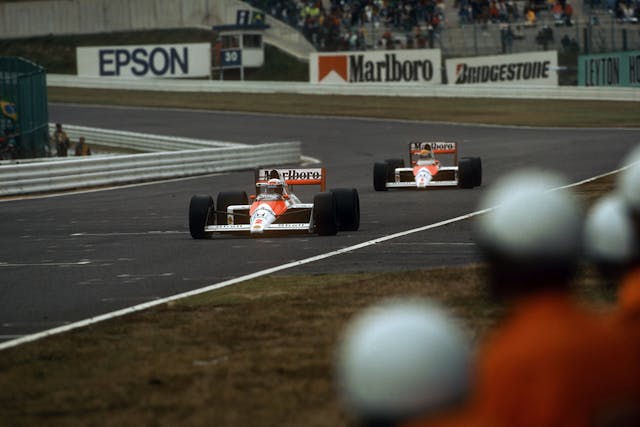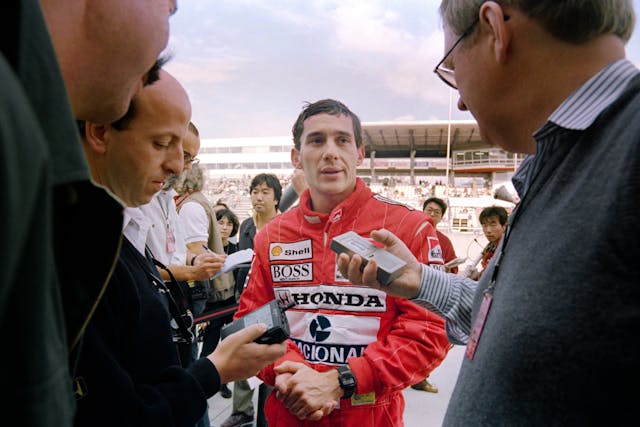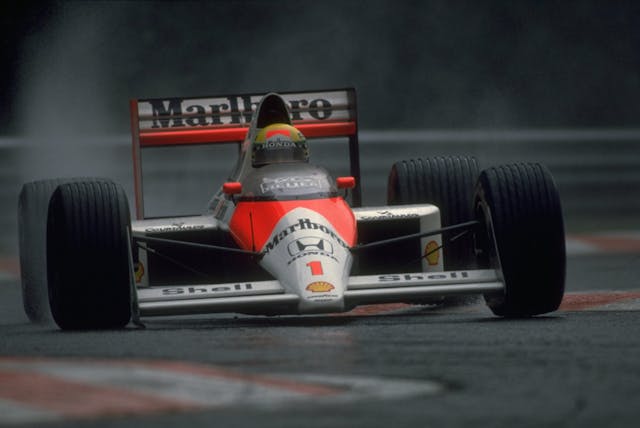1988 Japanese Grand Prix: Senna and Prost’s first world title face-off
If Ayrton Senna won the 1988 Japanese Grand Prix, he took his first Formula 1 championship. Simple as that. Trouble was, he was now sitting on the Suzuka starting grid in a McLaren that was crawling forwards while the rest of the field roared past his pole position at speed. Heading those drivers was his team-mate and title adversary Alain Prost.
The names Senna and Prost are synonymous with a bitter, at times almost unhealthy, rivalry. But their relationship wasn’t always like that. When Ayrton, the younger man, joined McLaren for ’88, it was more like healthy competition. However, by October’s Japanese Grand Prix, resentment was building.
Prost had led the championship until August, thanks to his metronomic consistency. He’d finish the 16-race season with a remarkable seven victories and seven second places. But Senna’s greater win rate meant he overhauled his rival in late summer.
Two grands prix before Japan, in Portugal, Senna had been so unwilling to accept his teammate overtaking him that he nearly ran the Frenchman into the Estoril pitwall. Prost was unamused. By September and the Japanese Grand Prix, Alain was back leading the title race.
He and Senna knew that given the way the points system worked—only the best 11 scores counted—the championship was going the Brazilian’s way if he won in either Japan or the next round in Australia.
But on October 30, 1988, at the front of the Suzuka grid, Senna was literally powerless.

He dipped the clutch, and his Honda V-6 briefly coughed into life before dying again. Then it fired properly—he was away. His start nightmare had taken little more than a second but, this being F1, he entered the first corner in 14th.
He was never going to stay there. By the end of lap one, the red-and-white McLaren was up to eighth place. Prost meanwhile had broken the brief challenge of Gerhard Berger’s Ferrari and looked as if he had the win in his pocket.
On lap two Senna passed Riccardo Patrese’s Williams and the Benetton of Alessandro Nannini. A lap later, he overtook Thierry Boutsen in the other Benetton and the lap after that he was into fourth, Michele Alboreto’s Ferrari in his mirrors.
By lap 12, Prost found his lead under pressure. But the challenge wasn’t from Senna.
Ending lap 16 as they accelerated out of the chicane onto Suzuka’s start-finish straight, Prost missed a gear. In an instant, Ivan Capelli in his racy, Adrian Newey–designed March was alongside him. When they crossed the timing beam to start lap 17, Capelli was actually ahead of Prost. But his 3.5-liter Judd V-8 was no match for the McLaren’s 1.5-liter Honda turbo and Prost had edged back into the lead by the first corner.
Capelli’s glory was short-lived. Two laps later, he coasted to a stop beside the pit wall. The Italian’s retirement hadn’t just elevated Senna to second; his battle for the lead with Prost had enabled the Brazilian to close on his teammate.
On lap 15, Senna was 10.4 seconds behind Prost. By the time Capelli went out, that gap had shrunk to 6.1 seconds. Ayrton was reeling in his rival.

By the start of lap 27, the pair came up to lap the Rial of Andrea de Cesaris. As Prost passed the Italian on the outside, Senna launched himself down the inside. Prost then moved back and started to intimidate his Brazilian team-mate towards the pit wall. It was the reverse of Estoril but the result was the same. The squeezed driver—in this case, Senna—kept his foot in, claiming the inside line and snatching the lead at the first corner.
Senna started increasing the gap to Prost. But that first world championship wouldn’t be gifted to the Brazilian. With five laps to go, a fine rain began to fall around the Suzuka circuit. Despite his renowned wet-weather skills, Senna was unsettled, furiously pointing skywards whenever he drove past the pits. He was doubtless thinking of Monaco, when an unforced error 12 laps from the end, as he held a commanding lead, forced him to retire. Or perhaps the Brazilian was thinking more recently about Italy where he’d collided with a back marker two laps from the finish while leading, allowing Berger’s Ferrari to win.
He needn’t have worried. His mastery of the slippery conditions saw him reel off the final few laps and cross the line a comfortable 13 seconds ahead of Prost. Alain had done his best, but on this occasion, it wasn’t enough to keep Ayrton at bay.
It was the first of Senna’s three world championships and he bore out the old saying that the first time is the most special. As the low-slung McLaren MP4/4 crossed the finish line the Brazilian raised both arms in jubilation.

His eighth win of 1988 had broken Prost’s four-year old record for the most grands prix wins in a season. Senna’s uncontrolled whooping over the car-to-pits radio was so deafening that McLaren team members on the pit wall yanked off their headsets.
McLaren-Honda went on to win all but one of the year’s 16 races. On the way, the red-and-white cars led an astonishing 2872 of 2950 racing miles.
Prost took little satisfaction from his astonishing finishing record, which meant he’d scored more points than Senna over the season but lost the title. Perhaps he knew what was to come. Twelve months later at the same track, he and Senna collided at the chicane as they battled over the championship. A year after that, they crashed again at Suzuka, when Senna willfully took Prost out as they contested the first corner. By then their relationship was one of open hostility, the Senna-Prost rivalry written into F1 lore.
The 1988 Japanese Grand Prix was without doubt a better race, when two of the greatest racing drivers in the world went head-to-head in tricky conditions to contest what many consider the biggest prize in motorsport.
Check out the Hagerty Media homepage so you don’t miss a single story, or better yet, bookmark it.



Fascinating and memorable. I set my alarm to catch the 1988 Japanese Grand Prix live on ESPN but slept right through and had to watch the re-broadcast (when I knew who had won.)
Note – most of the photos with the article depict the McLaren MP4/5 – the 1989 car which was powered by a Honda V-10. The MP4/4, deployed by McLaren for 1988, was the end of the Turbo Wars and won 15 of 16 races in ’88.
May all of us bat .93750 in all of our endeavors.